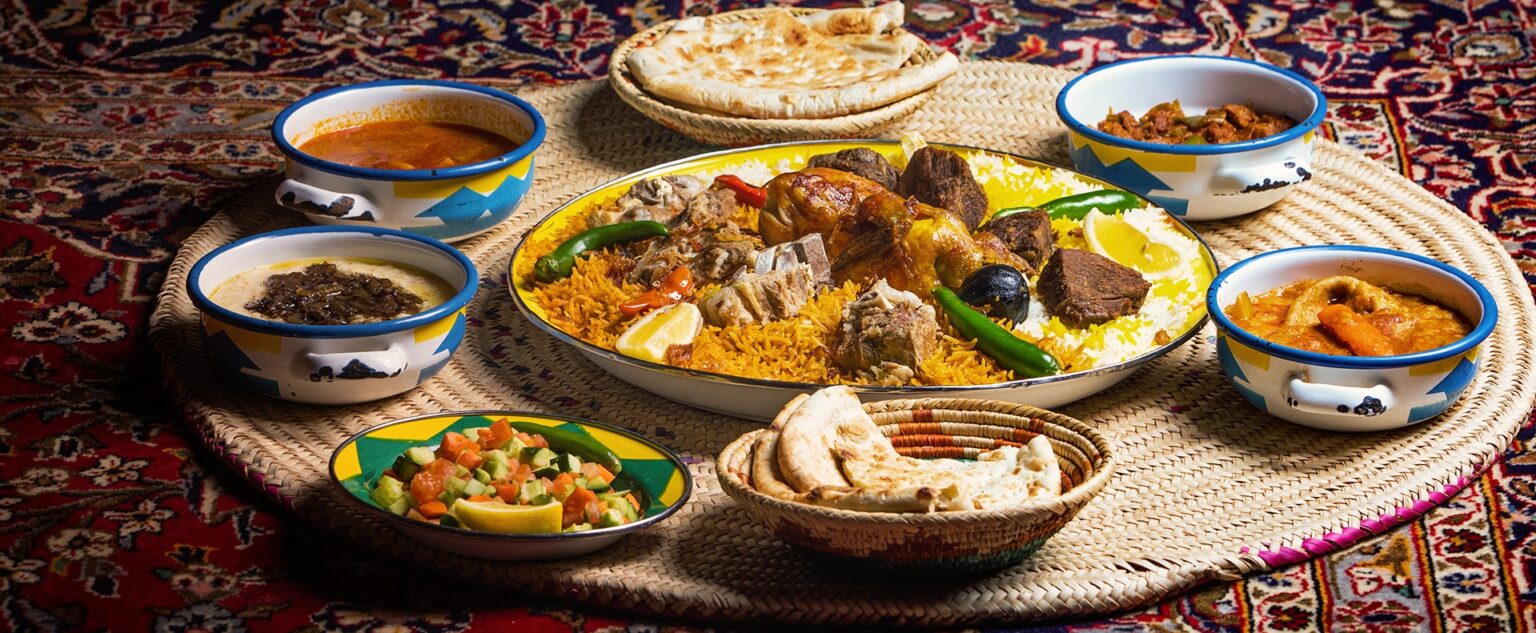The influence of Bedouin heritage on Saudi Arabia’s food is deeply rooted in the nation’s history, geography, and way of life. Bedouins, the nomadic Arab tribes who lived in the deserts of the Arabian Peninsula, developed a food culture based on simplicity, survival, and hospitality. Today, these traditions continue to shape the identity of Saudi cuisine, making it unique, flavorful, and full of cultural pride.
This article explores how the influence of Bedouin heritage on Saudi Arabia’s food is visible in traditional ingredients, cooking methods, community values, and culinary rituals that still flourish in the modern kingdom.
1. The Bedouin Desert Lifestyle Defined the Cuisine

The Bedouin people lived in harsh desert conditions, where access to water and vegetation was limited. Their food had to be practical, long-lasting, and nutritious. Staples like dates, milk, yogurt, wheat, rice, and dried meat were easy to store and carry during long travels. This resourceful approach to food is a major part of the influence of Bedouin heritage on Saudi Arabia’s food today.
Even in urban Saudi households, these foods remain common, reflecting a cultural connection to the past. Dishes such as date-based desserts and laban (fermented milk drink) are still widely consumed.
2. Bedouin Hospitality Lives On Through Food Traditions
One of the most respected customs in Bedouin culture was hospitality. Hosting a guest with generosity—even in the middle of the desert—was considered a great honor. Food was central to this tradition.
A classic example is the serving of Arabian coffee (qahwa) and dates to guests. Even today, when someone visits a Saudi home, they are welcomed with these items. The influence of Bedouin heritage on Saudi Arabia’s food is most visible in how food is used as a symbol of generosity and respect.
3. Simplicity and Tradition in Cooking Methods
Another strong influence of Bedouin heritage on Saudi Arabia’s food is in its traditional cooking techniques. Since Bedouins did not have modern kitchens or appliances, they used open fires, hot stones, and underground pits for cooking.
A popular dish called mandi, cooked in an underground oven, is still a staple across Saudi Arabia. Other dishes like kabsa, a rice-based meal made with meat and spices, also follow old Bedouin preparation styles using minimal equipment but rich, slow-cooked flavors.
4. The Role of Camels and Goats in Diet
Camels and goats were essential to Bedouin survival, providing transportation, milk, meat, and hides. Their importance is reflected in Saudi cuisine today. Camel meat is considered a delicacy and is often served during large gatherings or festive occasions.
Goat meat and goat milk also remain popular, used in dishes like jareesh (cracked wheat with meat or dairy) and haneeth (meat slow-cooked with spices). This reflects how the influence of Bedouin heritage on Saudi Arabia’s food preserved the value of native livestock in national cuisine.
5. Spices That Tell a Story
Spices were treasured by Bedouins and carefully used to preserve and flavor their food. Due to trade routes that crossed the Arabian Peninsula, they had access to ingredients like cardamom, cinnamon, cumin, and cloves.
These spices still dominate Saudi cooking. From the warm, earthy notes of kabsa to the aromatic blend in mutabbaq (stuffed pancakes), the influence of Bedouin heritage on Saudi Arabia’s food includes a flavorful legacy of spice combinations that tell a story of both survival and trade.
6. Food as Part of Oral Culture and Identity
The Bedouin way of life involved oral storytelling, poetry, and singing. Food was often part of these gatherings and shared experiences. Recipes were passed down verbally, preserving culinary knowledge through generations.
Today, Saudi families often have their own variations of traditional dishes, reflecting a long lineage. Women in rural areas continue to cook using methods their grandmothers taught them, showing how the influence of Bedouin heritage on Saudi Arabia’s food has kept traditions alive through storytelling and family rituals.
7. Seasonal and Regional Diversity Rooted in Nomadic Life

Due to their migratory lifestyle, Bedouins adapted their diets based on regional availability. This led to a variety of food styles across Saudi Arabia’s different regions, each shaped by local climate and ingredients.
For example, in the Najd region, wheat and dates are central, while in the Hijaz, seafood and spicy dishes dominate due to Red Sea access. This diversity, inspired by Bedouin adaptability, is a living example of how the influence of Bedouin heritage on Saudi Arabia’s food remains relevant across the kingdom.
Conclusion
The influence of Bedouin heritage on Saudi Arabia’s food is more than a historical detail—it is the foundation of the country’s culinary identity. From simple cooking techniques and desert-friendly ingredients to values of hospitality and storytelling, Bedouin traditions continue to guide how Saudis eat, cook, and share food.
In a world of fast food and modern dining, the heart of Saudi cuisine remains rooted in its Bedouin past. This heritage gives Saudi food a timeless authenticity that not only satisfies hunger but also tells the story of a people, their land, and their enduring culture.
Also Read – 7 Delicious Ramadan Food Customs in Saudi Arabia Revealed



